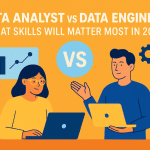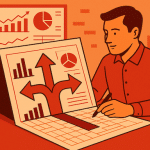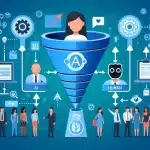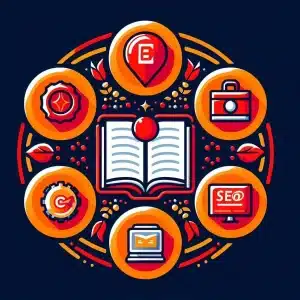
What Will B2B Clients Look for in SaaS Platforms in 2025?
The B2B SaaS industry is booming, bringing in amazing innovations that help businesses cut costs, work smarter, and deliver standout experiences for their customers. But for any Saas company, staying competitive means being one step ahead, ready to lead the way in their field. We’ve explored the latest trends and what clients are expecting, and here’s a handy list of key questions B2B SaaS providers should be asking themselves as they plan for an exciting 2025.
How Can B2B SaaS Platforms Deliver Exceptional User Experiences for Diverse User Groups?
In B2B, user teams span multiple departments, with various roles and expertise levels, making adaptable UX design essential. How can SaaS platforms ensure B2B buyers that they cater to finance specialists, occasional users, and everyone in between? In 2025, clients will look for solutions that serve this spectrum of users through features like role-based dashboards, intuitive navigation, and customised onboarding experiences.
Why it matters: A SaaS provider who demonstrates a user-centric approach to deliver customer success—detailing how their UX design meets the needs of different users—will resonate with clients looking for seamless, team-friendly software.
Are You Testing UX Rigorously Enough to Meet Client Expectations?
Creating an intuitive platform is just the start—rigorous UX testing is what solidifies its usability. In 2025, clients expect every B2B SaaS company to demonstrate its dedication to testing. This includes methods like usability testing with real users and A/B testing to collect customer feedback and refine the interface for diverse user types. This also gives your existing customers the knowledge that you are dedicated to constantly improving your product. Here’s a quick look at leading UX testing providers:
- UserTesting: UserTesting allows companies to observe and gather feedback from real users as they interact with a product. It provides video feedback and insights that help identify friction points and assess the overall user experience.
- Optimal Workshop: Optimal Workshop offers tools for conducting card sorting, tree testing, and surveys, helping UX designers understand how users navigate and interpret the structure of the platform.
- Lookback: Lookback enables remote usability testing with real-time video interviews and screen recordings, allowing testers to observe users as they interact with the platform and hear their immediate reactions.
- Maze: Maze provides rapid prototype testing, enabling UX teams to validate design choices early. Maze also offers analytics that highlight how users navigate through tasks, which helps refine the user journey.
- Hotjar: Hotjar combines heatmaps, session recordings, and feedback polls, offering a robust set of tools to understand user behaviour and identify usability issues based on real user interactions.
Why it matters: Clients value the assurance that a platform’s usability is thoroughly vetted before it goes live. SaaS providers can use details of their UX testing process to strengthen client communications, respond to customer needs and build confidence in the platform’s quality and reliability.
Are You Integrating AI and Automation to Drive Efficiency?
In 2025, B2B clients expect SaaS platforms to offer advanced AI capabilities and automation that go beyond basic functions. Predictive analytics, dynamic workflows, and tailored interfaces powered by AI are becoming standard expectations. SaaS providers need to demonstrate how their platforms reduce manual work and improve decision-making through AI-driven insights.
AI features clients will look for:
- Predictive analytics: Enabling proactive measures, like identifying potential customer churn and suggesting retention strategies.
- Automation: Supporting tasks with multi-step processes that free users from repetitive actions and reduce human error.
- Personalisation: Tailoring user interfaces to adapt to individual user preferences and patterns, creating a smoother, more relevant experience.
Why it matters: SaaS platforms that provide clear examples of how AI and automation boost efficiency will appeal to clients eager for streamlined workflows. Providers should communicate these features with concrete use cases and data-backed examples across RFPs, websites, and other materials.
Are You Offering Seamless Integration with Other Tools and Platforms?
In 2025, B2B clients will expect their SaaS tool to work effortlessly with the diverse ecosystem of tools they already rely on. Integration capabilities are no longer a nice-to-have; they are a crucial requirement for clients looking to streamline workflows, improve data accessibility, and maximise their technology investments. A SaaS product that can seamlessly integrate with CRM systems, project management tools, data visualisation software, and other essential platforms will be highly valued.
What Integration Features Should You Emphasise?
- API flexibility: A robust, well-documented API allows clients to connect their preferred applications easily, extending the functionality of your SaaS solution.
- Native integrations: Offering built-in integrations with popular tools like Salesforce, Microsoft 365, and Slack can enhance appeal, as these connections simplify user workflows and reduce setup time.
- Data synchronisation: Real-time data synchronisation across platforms enables clients to make data-driven decisions without delays, ensuring that information remains accurate and up to date.
- Customisable workflows: Providing options for clients to tailor integrations to their unique workflows demonstrates a commitment to flexibility and user empowerment.
Why it matters: Clients increasingly favour SaaS platforms that fit naturally within their tech stacks. Emphasising integration capabilities in your marketing materials, RFPs, and product demos can make your platform more attractive to clients who prioritise interoperability. Clear communication around integration options reassures clients that your platform will work seamlessly with their existing tools, reducing friction and promoting broader adoption.
Can You Offer the Level of Customisation B2B Clients Need?
In 2025, B2B clients will increasingly seek SaaS platforms that don’t just serve general industry needs but are adaptable to their specific requirements. Businesses want solutions that align closely with their unique workflows, objectives, and challenges. As a result, customisation options are becoming a key deciding factor for clients who need software that feels like it was built for them.
What Types of Customisation Will Clients Look For?
- Configurable dashboards and interfaces: Clients value the ability to adjust layouts and display only the most relevant data and tools, ensuring that their teams can work more effectively.
- Custom reporting and analytics: Tailoring reporting features to align with business-specific metrics allows clients to gain insights that are directly relevant to their goals and strategies.
- Flexible modules and features: The option to activate or deactivate certain features based on departmental needs or user roles enables clients to streamline their experience, making the platform more intuitive and efficient for all users.
- Branding and personalisation: Offering ways for clients to incorporate their brand identity into the platform, from logos to custom themes, helps them present a cohesive brand experience both internally and to their own customers.
Why it matters: SaaS providers who showcase their customisation capabilities demonstrate a readiness to support clients in creating a solution that feels bespoke. Including examples of customisation options in proposals, product demos, and sales conversations helps clients envision how the platform could fit into their specific operational landscape.
Are You Prioritising Data Privacy and Security to Build Trust?
Privacy regulations continue to evolve, and B2B clients in 2025 will scrutinise data security practices. Providers must go beyond basic compliance to integrate security as a core component of their offerings. By adopting privacy-by-design principles, SaaS companies can reassure clients that data protection is central to their platforms.
Key security measures to highlight:
- Zero-Trust architecture: Ensures continuous verification for all connections, reducing the risk of breaches.
- Encryption and Multi-Factor Authentication: Provides baseline security that protects data both in transit and at rest.
- Transparent data governance: Outlining how data is stored, processed, and safeguarded aligns with regulatory standards.
Why it matters: SaaS providers who clearly outline these security protocols within sales, RFPs, and marketing materials can build client trust. A strong stance on data privacy sets providers apart in a field where data sensitivity is paramount.
Can Your SaaS Platform Scale as Your Clients’ Businesses Grow?
Scalability will be a critical factor for B2B clients choosing SaaS platforms, as they seek solutions that can keep pace with their growth. Whether expanding to new markets, increasing user numbers, or adding more complex functionalities, businesses need software that can evolve alongside them without requiring costly overhauls or disruptive transitions. SaaS providers that offer flexible scalability can position themselves as reliable partners for clients’ long-term ambitions.
What Makes a Platform Scalable?
- Modular architecture: A platform built with modularity allows clients to add or remove features as needed, accommodating growth without requiring a full redesign.
- Capacity to handle growing data volumes: As businesses grow, so does their data. Clients will prioritise platforms that can efficiently manage larger data sets, ensuring performance remains high even as usage increases.
- Flexible licensing and user options: Offering scalable licensing models that adapt to different stages of growth—from a small initial team to a full-scale enterprise rollout—provides clients with a practical, cost-effective way to expand.
- Infrastructure and performance reliability: Platforms with robust cloud infrastructure and the capacity to handle spikes in usage or concurrent user activity reassure clients that they won’t experience performance lags as their needs scale.
Why it matters: B2B clients want a SaaS platform they can rely on today and in the future. By emphasising your solution’s scalability in your marketing materials, website, and RFP responses, you can convey a commitment to supporting clients through every stage of their growth journey. Scalable solutions not only save clients from costly transitions but also build trust, reinforcing that your platform is ready to grow as they do.
How Are You Addressing Fraud Prevention to Protect Clients?
With cyber threats on the rise, fraud prevention is a top priority for clients handling sensitive data. In 2025, SaaS platforms need proactive fraud prevention measures to remain competitive. By incorporating real-time threat monitoring, AI-driven fraud detection, and user education, SaaS providers can offer an extra layer of security.
Effective Fraud Prevention Tactics:
- AI-driven threat detection: Monitors user behaviour and flags suspicious activity, adding a vital layer of security.
- User education resources: Providing webinars and guides on password security and phishing recognition builds a security-conscious user base.
- Crisis communication plans: Clients appreciate transparency in the event of an incident; a robust communication plan helps manage client relationships in high-stress scenarios.
Why it matters: Communicating these security practices not only reassures clients but also differentiates the platform as a trustworthy solution. Including these points in onboarding materials, support resources, and marketing content can foster client confidence from day one.
Are You Offering the Support and Training B2B Clients Need to Succeed?
Comprehensive support and training will also be essential differentiators. As platforms become more sophisticated, businesses are looking for partners who not only deliver advanced solutions but also equip their teams with the knowledge and assistance to use these tools effectively. SaaS providers that prioritise support and training can boost the customer experience, ensuring users make the most of the platform’s features from day one.
Key Areas of Support and Training to Emphasise:
- Onboarding programmes: Tailored onboarding experiences that guide users through the platform’s core features and functionalities make a significant difference in adoption rates. Interactive tutorials, step-by-step guidance, and live demos help users feel comfortable and competent from the start.
- Ongoing training resources: Clients appreciate platforms with accessible training resources, including video tutorials, webinars, and self-paced courses. These resources enable teams to upskill as they use the platform, empowering them to leverage advanced functionalities.
- Responsive customer support: Fast, effective customer support—whether through live chat, email, or a dedicated account manager—reassures clients that assistance is readily available should issues arise. Offering multiple support channels shows commitment to solving client problems efficiently.
- Knowledge base and community forums: A well-maintained knowledge base, paired with community forums where users can share insights and tips, provides a valuable resource for troubleshooting and learning. Clients value the ability to find answers independently and connect with other users.
Why it matters: In a competitive SaaS landscape, strong support and training offerings can set a platform apart. By highlighting your approach to onboarding, support, and continuous learning within RFP responses, marketing materials, and website content, you reinforce your commitment to client success. Emphasising these resources assures clients that they’re choosing a platform backed by a dedicated team ready to support their goals every step of the way.
Are You Communicating Your USPs Across Every Client Touchpoint?
Meeting client expectations in 2025 requires more than just building the right features. B2B SaaS solution providers must ensure these USPs are visible across all client touchpoints:
- Website content: Each page should spotlight the platform’s strengths, with client testimonials and case studies reinforcing these points. Make it a key marketing channel and put it at the heart of your SaaS marketing strategy.
- Sales materials & RFPs: Use benefit-driven language, real-world examples, technical details and data-backed results to drive lead generation and make a compelling case to a potential client.
- Onboarding & support resources: Reinforce USPs in FAQs, onboarding guides, and customer support resources, ensuring clients feel supported and informed throughout their experience. This will increase user retention.
Good Luck in 2025!
Being a SaaS developer has never been as exciting, but it’s also never been as competitive and demanding. By staying in tune with what B2B clients will prioritise, from advanced AI-driven capabilities and strong data security to seamless user experiences, your platform will be well-positioned to stand out. Following the strategies above will ensure you’re not only ahead of industry trends but also delivering best-in-class solutions that truly meet the needs of your B2B customers.




















